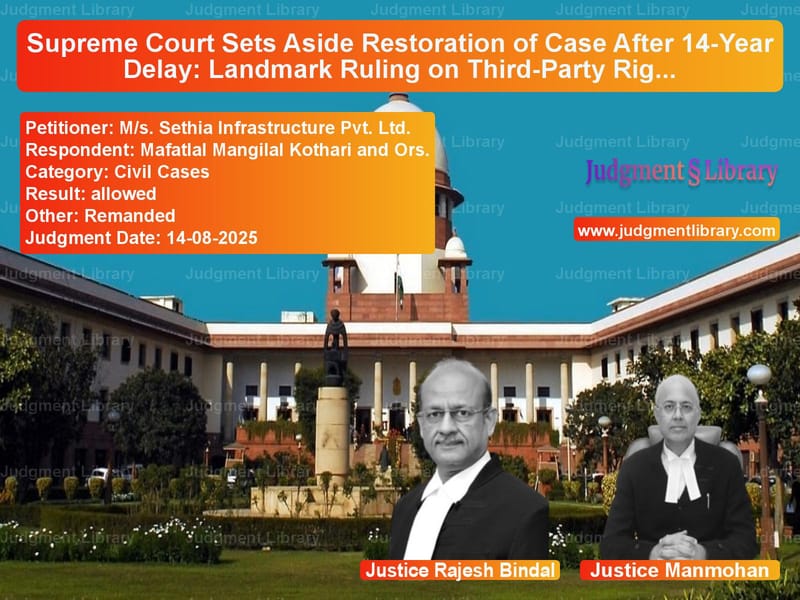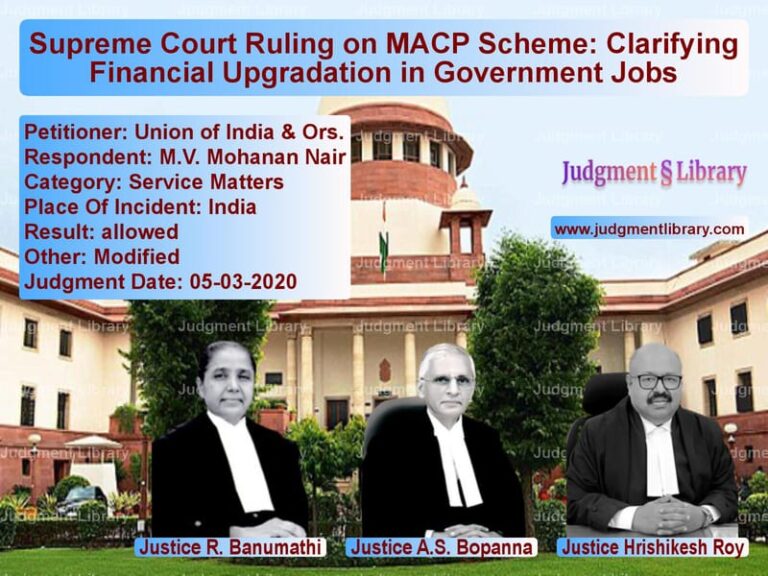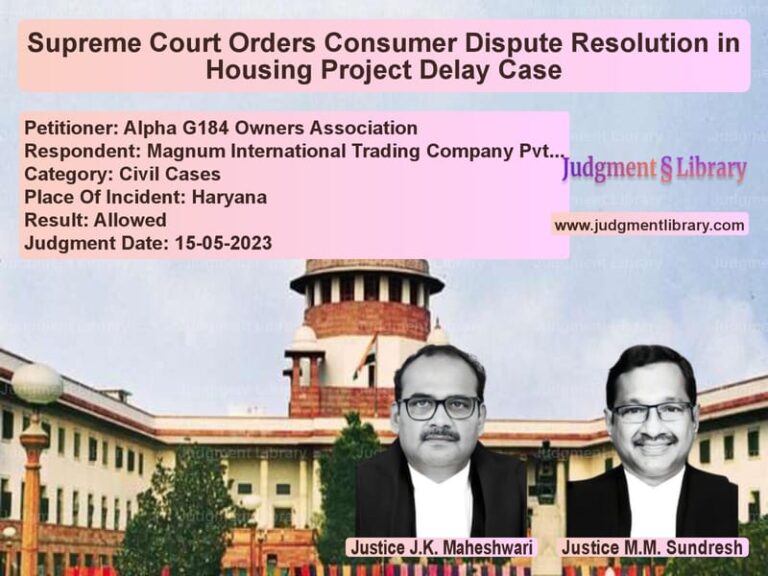Supreme Court Sets Aside Restoration of Case After 14-Year Delay: Landmark Ruling on Third-Party Rights
In a significant judgment that underscores the importance of timely legal proceedings and protects the rights of third parties, the Supreme Court of India has set aside a Bombay High Court order that had restored a long-dormant property dispute case after an astonishing delay of 5,250 days – nearly 14 years. The ruling emphasizes that courts must be mindful of third-party rights that may have been created during prolonged delays in litigation.
The case involves a property dispute with a long and complicated history that dates back to 1967. The legal battle began when respondents Mafatlal Mangilal Kothari and others filed a suit seeking eviction of defendants from a disputed property. After two decades of legal proceedings, the suit was dismissed by the trial court on July 7, 1988. The plaintiffs then filed First Appeal No. 1483 of 1988 before the Bombay High Court, which was admitted on March 7, 1989.
The appeal remained pending for nearly two decades until February 20, 2008, when the High Court passed a crucial order giving the appellants three months to file compilation of pleadings. The court explicitly stated: “If compilation of pleadings is not filed by the appellants within a period of three months from today, the Appeal will stand dismissed for non-prosecution without further reference to the Court.” When the appellants failed to comply with this direction, the appeal stood automatically dismissed three months later on May 20, 2008.
What happened next was extraordinary. Instead of promptly seeking restoration of the appeal, the respondents waited for an astonishing 5,250 days – approximately 14 years – before filing an application for restoration along with a prayer for condonation of this massive delay. The Bombay High Court, in an order dated October 25, 2023, condoned this enormous delay and restored the first appeal for decision on merits.
The High Court’s restoration order was remarkably brief, stating only: “It appears that respondents are duly served by private service in view of affidavit of service filed on record dated 29th March 2023 and 17th August 2023. For the reasons stated in the application and in view of the ratio in (2008) 11 S.C.R. 1, application is allowed in terms of prayer clause (a).” This order was passed in the absence of representation from the non-applicants, with the court merely noting that private service was complete based on an affidavit filed by the applicant.
Aggrieved by this order, M/s. Sethia Infrastructure Pvt. Ltd., which had developed third-party rights in the property during the 14-year period when the appeal remained dismissed, approached the Supreme Court. The appellant company argued that they had stepped in as developers and were carrying out construction at the site on a mega scale during the period when the appeal remained dismissed for non-prosecution.
The Supreme Court bench comprising Justices Rajesh Bindal and Manmohan heard the appeal and delivered a strongly worded judgment setting aside the High Court’s order. The court made several crucial observations about the principles that should guide courts when dealing with applications for restoration filed after enormous delays.
The court emphasized: “We may only observe that when a Court is dealing with an application for restoration of any matter which is dismissed for non-prosecution and the application for restoration is filed after huge delay, the Court must be cognizant of the fact that time does not stand still. Whenever delay of a long period of time is sought to be condoned, the Court should not rule out involvement of third parties in the litigation. In fact, the Court must presume that third party rights may have been created and/or additional parties may have developed rights and interest in the litigation.”
This observation highlights a fundamental principle of justice – that legal disputes cannot remain suspended indefinitely while the world moves on around them. The court recognized that during prolonged delays, properties change hands, developments occur, and third parties invest resources and acquire rights in good faith, all of which must be protected.
The Supreme Court was particularly critical of the High Court’s approach in dealing with such a massive delay without proper consideration of all relevant factors. The court noted that the impugned order was passed in the absence of representation of the non-applicants, and no reasons were assigned for condoning the huge delay of 5,250 days.
The court also made a significant observation about the possible motives behind the sudden revival of the long-dormant case: “In the present case, it prima facie seems that respondent has woken up from his ‘alleged slumber’ as the respondent has much to gain inasmuch as the appellant/developer has stepped in and is carrying out construction at site on a mega scale.”
This remark suggests that the court was mindful of the possibility that the respondents may have chosen to revive the case only after seeing the development potential of the property being realized by the appellant company, rather than due to any genuine desire to pursue their legal rights in a timely manner.
After considering all aspects of the case, the Supreme Court concluded: “In our view, the impugned order passed by the High Court cannot be legally sustained. The same is accordingly set aside. The appeal is accordingly allowed. The matter is remitted back to the High Court.”
The court directed that the application for condonation of delay shall be decided afresh after hearing the appellant/developer, who claims to have started developing the suit property during the time period the appeal remained dismissed. The court also indicated that if necessary, the appellant may be impleaded as a party to ensure that their rights and interests are properly represented and protected.
The Supreme Court specifically directed: “Consequently, the application for condonation of delay shall be decided afresh after hearing the appellant/developer, who claims to have started developing the suit property during the time period the appeal remained dismissed. If need be, it may be impleaded as party.”
The parties were directed to appear before the High Court on September 2, 2025, and the matter is to be listed as per the roster. This gives the High Court an opportunity to reconsider the application for condonation of delay after properly hearing all affected parties, including the appellant developer whose rights were created during the 14-year period when the appeal remained dismissed.
This judgment serves as an important reminder of several key legal principles. First, it reinforces that courts must be extremely cautious when dealing with applications for condonation of enormous delays, particularly when third-party rights may have been created during the period of delay. Second, it emphasizes that restoration applications cannot be decided mechanically or without proper consideration of all relevant circumstances. Third, it highlights that justice requires balancing the interests of all parties, including those who may have acquired rights in good faith during prolonged legal delays.
The Supreme Court’s ruling protects the legitimate expectations of parties who invest resources and develop properties based on the current legal status, without having to worry about long-dormant cases suddenly being revived after more than a decade. At the same time, it doesn’t completely shut the door on the original litigants – it merely requires that their application for condonation of delay be properly considered after hearing all affected parties.
This case illustrates the delicate balance courts must maintain between allowing legitimate claims to be pursued and protecting the stability of legal transactions and third-party rights. The Supreme Court’s approach ensures that while justice should not be denied due to technicalities, it also should not come at the cost of undermining the legitimate rights of those who have acted in good faith during extended periods of legal inactivity.
Petitioner Name: M/s. Sethia Infrastructure Pvt. Ltd..Respondent Name: Mafatlal Mangilal Kothari and Ors..Judgment By: Justice Rajesh Bindal, Justice Manmohan.Judgment Date: 14-08-2025.Result: allowed.
Don’t miss out on the full details! Download the complete judgment in PDF format below and gain valuable insights instantly!
Download Judgment: ms.-sethia-infrastr-vs-mafatlal-mangilal-ko-supreme-court-of-india-judgment-dated-14-08-2025.pdf
Directly Download Judgment: Directly download this Judgment
See all petitions in Property Disputes
See all petitions in Landlord-Tenant Disputes
See all petitions in Contract Disputes
See all petitions in Damages and Compensation
See all petitions in Judgment by Rajesh Bindal
See all petitions in Judgment by Manmohan
See all petitions in allowed
See all petitions in Remanded
See all petitions in supreme court of India judgments August 2025
See all petitions in 2025 judgments
See all posts in Civil Cases Category
See all allowed petitions in Civil Cases Category
See all Dismissed petitions in Civil Cases Category
See all partially allowed petitions in Civil Cases Category







